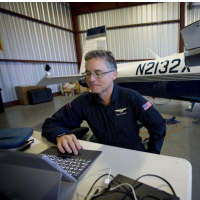Los Angeles Gas Leak Deemed Biggest Methane Release in U.S. History
 Stephen Conley (photo: Joe Proudman, UC Davis)
Stephen Conley (photo: Joe Proudman, UC Davis)
By Brian Melley, Associated Press
LOS ANGELES (AP) — A natural gas leak that sickened Los Angeles residents and forced thousands from their homes was the largest known release of climate-changing methane in U.S. history, scientists reported Thursday.
The 16-week blowout from a well at a Southern California Gas Co. storage facility spewed 107,000 tons of the powerful greenhouse gas methane, according to a study published in the journal Science.
While preliminary figures from the study were previously reported, the article includes final results and puts the leak in context with other disasters and other sources of global warming. The findings are important as the state moves forward with plans to make SoCalGas mitigate the environmental impact of the blowout.
The study was released the same day displaced residents staying in short-term housing were due to return home, but a judge issued an order requiring the gas company to provide housing for three more weeks.
The leak first reported Oct. 23 at the Aliso Canyon storage facility near Porter Ranch released the greenhouse gas equivalent of 572,000 cars in a year, the report said.
The total amount of natural gas released was second only to the collapse of an underground storage facility in Moss Bluff, Texas, in 2004, the report said.
In that case, methane — a more potent greenhouse gas than carbon dioxide — burned off in a fireball so its climate impact wasn't as great as the Aliso Canyon event, said Stephen Conley, an atmospheric scientist at University of California, Davis, who co-authored the article.
"In terms of climate impact, this is the largest," Conley said of the California leak. "If you're specifically looking at that, this is the winner."
The total methane released weighed the equivalent of two aircraft carriers and at its peak it discharged enough gas to fill a balloon the size of the 92,000-seat Rose Bowl every day.
The leak had been gushing nonstop for two weeks when Conley was sent in November by the California Energy Commission to fly near Porter Ranch in his small plane outfitted to measure methane.
As he took a pass through the invisible plume, he did a double-take at results that showed up on his laptop computer.
He was accustomed to flying about a half-mile from a leak and finding methane measurements of 3 parts per million in a big leak and 4 parts per million in a huge one. He was a mile from this leak and the readings spiked at 50 parts per million over the San Fernando Valley.
"What the hell is that?" he remembered thinking. "Do I have a problem?"
He checked a second instrument and it was no false alarm.
"Before we went, no one had any idea the magnitude of it," Conley said.
Rob Jackson, an environmental scientist at Stanford University who did not contribute to the study, said it was important to have an independent measure of the emissions.
The gas company has not publicly reported how much gas it lost but said in a Securities and Exchange Commission filing that about 5 billion cubic feet escaped. That is similar to Conley's finding.
SoCalGas said in the SEC filing on Feb. 11 that it expects the blowout to cost $250 million to $300 million to pay for lost gas, capping the well and relocating 6,400 families.
The figure, which does not include potential penalties from government agencies or damages from more than 65 lawsuits, could go higher after a judge Thursday ordered the company to continue paying for short-term housing for those who have moved out of their homes.
The company had agreed under an extended court settlement to pay until Thursday for residents staying in hotels and with family and friends. Those who moved to apartments and rental homes can stay as late as April 30.
But lawyers for the county successfully argued that although the leaking well has been capped, more time is needed to test that air is safe for residents to return.
The leak has been blamed for bloody noses, headaches, nausea, rashes and respiratory problems. Some residents who returned home already have continued to complain of symptoms.
But the company, which said it was paying about $2 million a day in housing costs, argued that public health officials found there was no reason residents couldn't safely return.
"Unfortunately, today's ruling disregarded these findings," the company said in a statement.
To Learn More:
Massive Gas Leak Finally Capped (by Brian Melley, Associated Press)
Massive Gas Leak Could Put Crimp in New Porter Ranch Housing Development (by Ken Broder, AllGov California)
Los Angeles Sues Gas Company over Ongoing Massive Leak (by Ken Broder, AllGov California)
Hundreds Relocating to Get Away from Massive Month-Old Gas Leak (by Ken Broder, AllGov California)
- Top Stories
- Controversies
- Where is the Money Going?
- California and the Nation
- Appointments and Resignations
- Unusual News
- Latest News
- California Forbids U.S. Immigration Agents from Pretending to be Police
- California Lawmakers Urged to Strip “Self-Dealing” Tax Board of Its Duties
- Big Oil’s Grip on California
- Santa Cruz Police See Homeland Security Betrayal in Use of Gang Roundup as Cover for Immigration Raid
- Oil Companies Face Deadline to Stop Polluting California Groundwater





